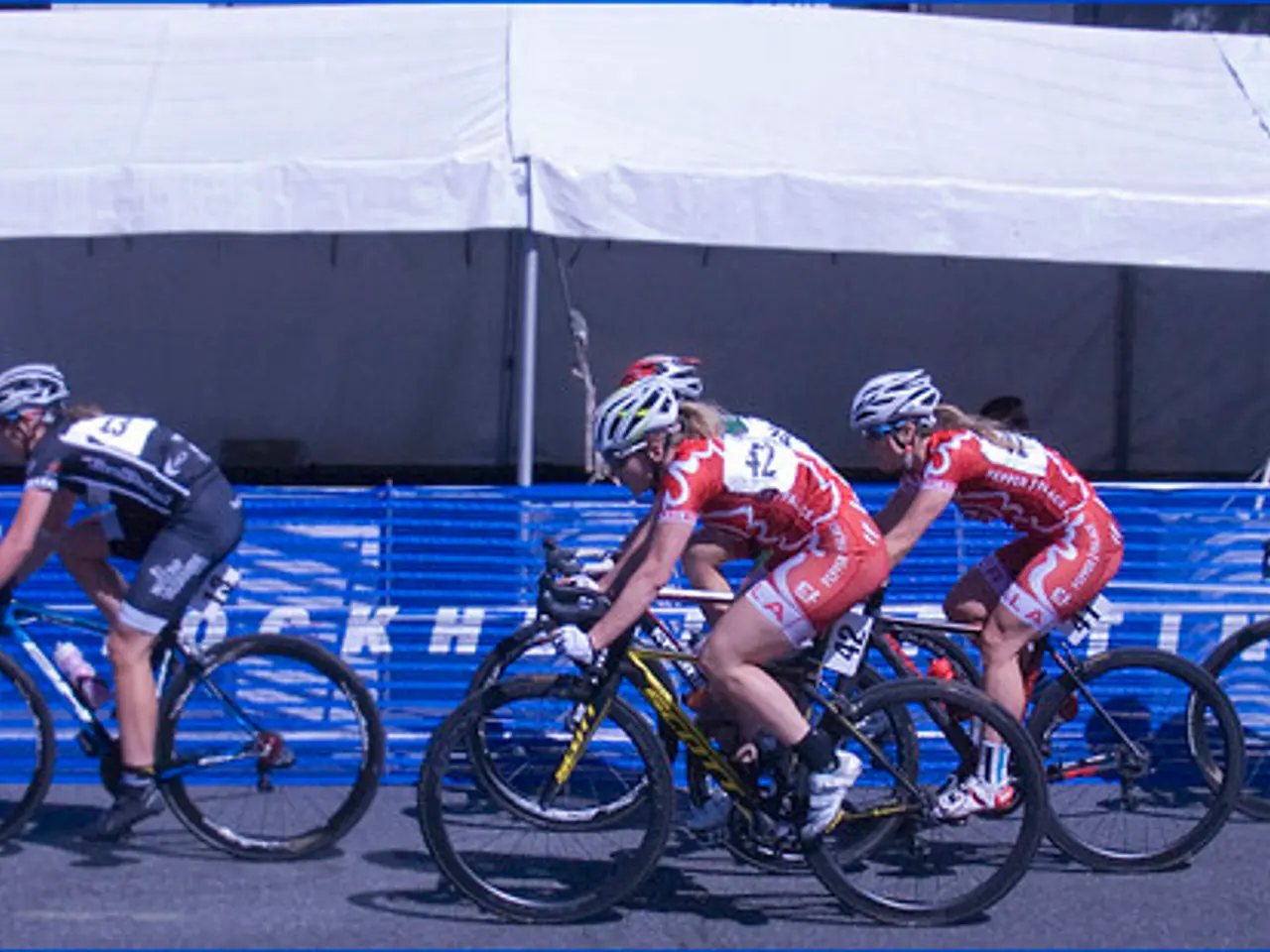Intensified Cycling Sessions with Resistance Bands: Revolutionizing Power and Stamina Training for Cyclists
Resistance band bicycle sprints are a versatile and effective workout that can be incorporated into any fitness routine, benefiting both professional athletes and enthusiasts alike. This unique exercise combines the intensity of cycling sprints with the added resistance of resistance bands, offering a multitude of benefits for cardiovascular health, muscle strengthening, and injury prevention.
Setting Up for Success
To reap the full benefits of resistance band bicycle sprints, it's essential to set up the workout correctly. Use bands that increase tension as they stretch, securely attaching them to a fixed point behind your sprint start position. Loop the bands around your waist or hips to create progressive resistance that is lighter at the start and harder as you accelerate, mimicking real sprint mechanics and increasing muscle activation during the strongest phase of the sprint.
Focus on Acceleration and Hip Extension
Each sprint should begin with a drive of full hip extension and explosive knee drive, which can be emphasized using resistance bands to encourage proper technique and power output during the acceleration phase. Aim for sprint durations of about 10-20 seconds to maximize anaerobic power and cardiovascular intensity without excessive fatigue.
Incorporate Sets and Rest
Perform 2-3 sets of sprints with resistance bands, aiming for high speed and power with each sprint. Rest adequately between efforts to maintain quality, around 1-3 minutes. This dynamic approach, working between 55-70% intensity with band tension, maximizes muscle recruitment and power development while limiting injury risk from overexertion.
Strengthen Supporting Muscles
To prevent injury, include complementary exercises targeting hips, glutes, and core, such as side planks with arm reaches to improve pelvis control and reverse lunge holds with bands to strengthen hip flexors and glutes. These exercises support sprint mechanics, reduce compensations, and prevent common running or cycling-related injuries.
Monitor Your Progress
Monitoring heart rate is crucial to ensure you're working within appropriate zones, especially zone 4 (80-90% MHR) during sprints, to maximize cardiovascular gains without overtraining. The band resistance also induces more muscle strain during sprints, promoting muscle strengthening along with endurance.
Consistency and Progression
Regularly perform these sprint sessions 1-2 times per week, progressively increasing resistance or sprint duration by about 5-10% every 2-3 weeks to sustain improvements in strength, power, and cardiovascular fitness. To see continued progress, gradually increase the thickness of the resistance band, increase the duration of sprints, reduce rest periods, or add more sprints to each session.
In conclusion, resistance band bicycle sprints offer a powerful workout that can help boost your fitness, improve cardiovascular health, and enhance muscle strength. By setting up the workout correctly, focusing on acceleration and hip extension, incorporating sets and rest, strengthening supporting muscles, monitoring your progress, and progressing consistently, you can maximize the benefits of this unique exercise.
- To experience the full advantage of resistance band bicycle sprints, it's vital to select bands that apply more tension as they stretch, securely attaching them to a stationary point behind your sprint starting position.
- Attaching the resistance bands around your waist or hips generates progressive resistance, lighter at the onset and harder as you gain momentum, replicating real sprint dynamics and boosting muscle activation during the peak sprint phase.
- Each sprint ought to initiate with a forceful drive of full hip extension and an explosive knee lift, which can be accentuated using resistance bands to foster proper technique and power output during the acceleration phase.
- Set sprint lengths for approximately 10-20 seconds to optimize anaerobic power and cardiovascular intensity while avoiding excessive fatigue.
- Perform 2-3 sets of sprints, striving for high speed and power with each sprint, and rest adequately between efforts for around 1-3 minutes to preserve quality and prevent excessive fatigue.
- To prevent injuries, incorporate supplementary exercises focusing on hips, glutes, and core, such as side planks with arm reaches, and reverse lunge holds with bands, which improve pelvis control and strengthen hip flexors and glutes.
- Monitoring your heart rate is crucial to work within suitable zones, specifically zone 4 (80-90% MHR) during sprints, to maximize cardiovascular development without overworking.
- Continuously perform these sprint sessions 1-2 times per week, gradually increasing resistance or sprint duration by about 5-10% every 2-3 weeks, to keep improving strength, power, and cardiovascular fitness.
- Incorporating resistance band bicycle sprints into your health-and-wellness and fitness-and-exercise regimen can help enhance overall fitness, improve cardiovascular health, and bolster muscle strength, while disciplined progression maintains these benefits according to the science of fitness training and weight loss cardio exercises.






